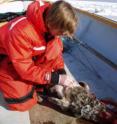Gray seals consume as much fish as the fishing industry catches
The grey seals in the Baltic Sea compete for fish with the fishing industry. The seals locally eat about the same quantities of cod, common whitefish, salmon, sea trout and eel as those taken by fishermen. This is the conclusion from research carried out at the University of Gothenburg, Sweden. Competing with the fishing industry
The grey seals in the Baltic Sea eat largely the same species and the same sizes of fish as those taken by the fishing industry. So even if the amount of fish eaten by seals is small relative to the total amount of fish caught in the Baltic Sea, the seals' dietary habits may have a major impact on the local availability of fish in the areas where they are common.
"If you compare the estimated consumption of fish by grey seals in their main range in Sweden, which is north of the Kalmar Sound, it is of the same order of magnitude as the total catch taken by Swedish professional and leisure fishermen in the same area," says scientist Karl Lundström.
Increasing population of seals
The grey seal was common at the beginning of the 20th century, but was hard hit by hunting and by environmental toxins, and only a remnant remained in the 1970s. However, the seal population has grown continuously since the middle of the 1980s, and this has led conflicts with the fishing industry.
"The conflict has mainly centred on the way in which seals eat from and destroy fishing gear, but as the number of seals has increased the possible competition for food resources has come into focus," says Karl Lundström.
Study of dietary habits
The scientists have studied the dietary habits of the seals in order to understand the role they play on the ecosystem, and how they influence the surroundings. This has been done not only by investigating prey remains in the digestive tracts of the seals but also by analysing the composition of fatty acids in their blubber. The fatty acid composition in the seals' blubber reflects the composition of fatty acids in the fish species that they eat, and can give an idea of the dietary patterns of the seals over a long period.
It became clear that the diet of grey seals differs between the northern and the southern Baltic. Herring was the most common food eaten by all seals, followed by common whitefish in the Gulf of Bothnia and sprat in the main body of the Baltic Sea. The diet of young seals differed from that of old seals, and the feeding habits of males differed from that of females.
"We have now developed useful methods and created a good starting point for further studies into the dietary habits of seals. We can also investigate the significance they have as fish-eating predators at the top of the marine ecosystem. By combining the methods that I have used with other techniques, it will be possible to increase our knowledge further. More closely focussed investigations in particularly interesting regions will also be needed, both for grey seals and ringed seals in the Baltic Sea and for common seals in the Kattegat and Skagerrak area," says Karl Lundström.
This is the first comprehensive investigation into the diet of the grey seal in the Baltic Sea since the 1970s.
Further info: http://gupea.ub.gu.se/handle/2077/28131



